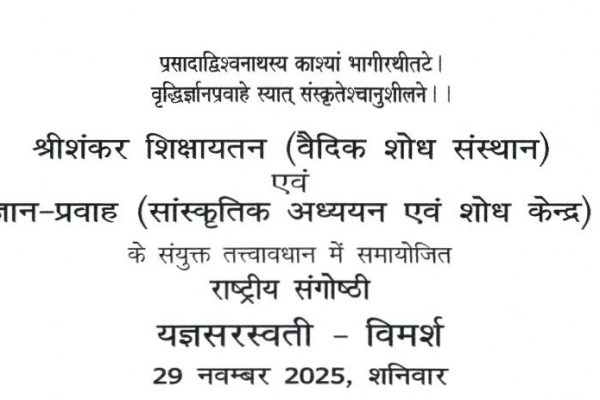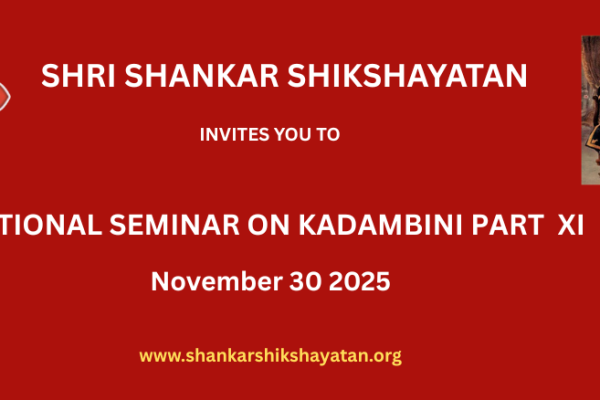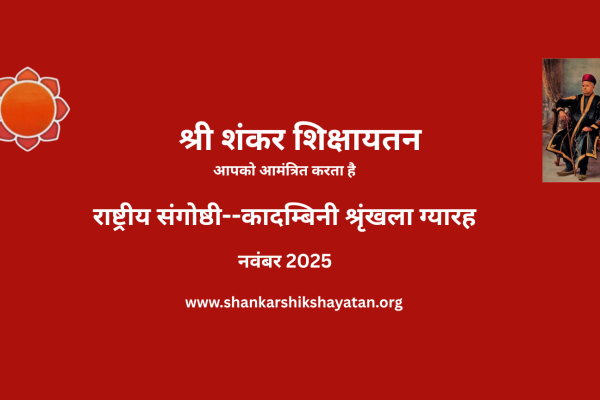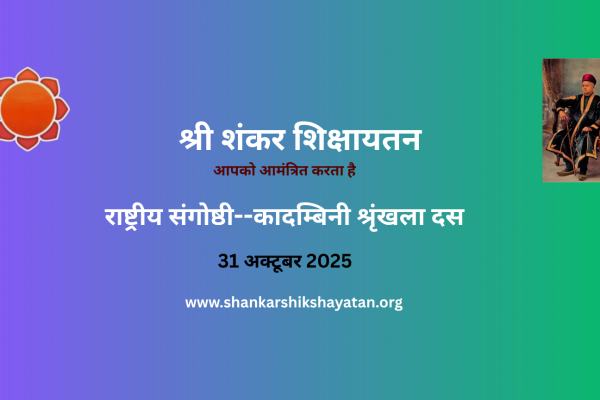Report The Shri Shankar Shikshayatan Vedic Research Institute organised a national seminar online on Tuesday, September 30, 2025, from 5:00 to 7:00 p.m. The seminar was based on various topics discussed in the Prakīrṇādhikāra (Miscellaneous Section) of Kādambinī, a text composed by Pandit Madhusudan Ojha. Dr. Abhishek Gautam, Assistant Professor, Department of Jyotiṣa, Central Sanskrit University, Rajiv Gandhi Campus, said in his address that the mark visible on the moon’s surface is in the shape of a crow (kāka). It is dark in color, appears fearsome, and triangular in shape. In the middle of the round lunar disk, there is a black, wedge-shaped spot. काकः कालाकृतिर्घोरस्त्रिकोणो वापि लक्ष्यते ।मण्डलं कीलकं मध्ये मण्डलस्यासितो ग्रहः ॥(Kādambinī, p. 180, kārikā 317) He explained that Ketu, which assumes a vast and many-formed appearance (Viśvarūpa), exists in 120 forms. These are red, shining, without crests, blazing, and appear to emit fire from the sky, surrounded by flames. विश्वरूपाः शतं विंशं शोणा दीप्ता विचूलिनः ।उद्गिरन्ति इवाग्निं खादग्निभा ज्वालामालिनः ॥(ibid., kārikā 318) Shri Govind Narayan Dixit, Assistant Professor, Department of Jyotiṣa, Central Sanskrit University, Vedavyasa Campus, said that the section of Kādambinī dealing with the Saṃpāta (intersection) has been elaborated in great detail. The path of the Moon is uneven, rising and falling; its form continuously changes. Astrologers well-versed in Jyotiṣa can recognize the five Pātakas (points of fall) associated with the Moon. उच्चावचश्चन्द्रमार्गो नित्यमेति विशेषताम् ।तस्मात् तत्र गताः पाताः पञ्चलक्ष्याः स्वयं बुधैः ॥(ibid., p. 178, kārikā 295) He further explained that in the Kādambinī, while defining Ketu, the text describes self-luminous masses of scattered light appearing in the sky, and these luminous bodies are known as Ketus. विकीर्णतेजसः केचित् स्वप्रकाशमया दिवि ।दृश्यन्ते जातुचित् पिण्डापिण्डास्ते केतवो मताः ॥(ibid., kārikā 296) Dr. Naveen Pandey, Assistant Professor, Department of Vāstuśāstra, Shri Lal Bahadur Shastri National Sanskrit University, explained that Kādambinī describes Ketu’s form through various similes (upamā). In the sky, Ketus appear fiery and red like hibiscus, fire, or lac, shining and crestless, spewing flames. Such fiery (āgneyāḥ) Ketus are said to be of twenty-five types. बन्धु-जीवाग्निलाक्षाभाः शोणा दीप्ता विचूलिनः ।उद्गिरन्ति इवाग्निं खादाग्नेयाः पञ्चविंशतिः ॥(ibid., p. 179, kārikā 305) Rough, crested, black, death-giving Ketus are of twenty-five kinds. Earthly (pārthiva) Ketus are round, crestless, and have a shining appearance like oil or water, numbering twenty-two types. रूक्षा वक्रशिखाः कृष्णा मृत्युदाः पञ्चविंशतिः ।भौमा द्वाविंशतिर्वृत्ता विचूलास्तैलतोयभाः ॥(ibid., kārikā 306) Prof. Santosh Kumar Shukla, Professor, Centre for Sanskrit and Indic Studies, Jawaharlal Nehru University, New Delhi, said that in the Prakīrṇādhyāya there are six natural phenomena or transformations (vikāras) described:Rāhu, Ketu, Tārā (stars), Dig-dāha (directional heat), Pāṃsu-varṣa (dust storms or showers), and Bhūkampa (earthquakes). राहवः केतवस्तारा दिग्दाहः पांसुवर्षणम् ।भूकम्पश्चेति षड्भावा उक्ता वैकारिकाह्वयाः ॥(ibid., p. 171, kārikā 216) Among these, the dark, unilluminated halves of celestial bodies such as the Earth, Moon, and Mercury are referred to as Svaṛbhānu, the shadowy aspect opposed to light. ये परज्योतिषः पिण्डाः पृथ्वी-चन्द्र-बुधादयः ।तेषां प्रकाशितादर्द्धादर्द्धमन्यत् तमोमयम् ॥(ibid., p. 172, kārikā 232) Dr. Prakash Ranjan Mishra, Assistant Professor, Department of Veda, Paurāhitya, and Karmakāṇḍa, Central Sanskrit University, Eklavya Campus, began the session with a Mangalacharaṇ chanted melodiously. The session was conducted by Dr. Lakshmikant Vimal, Research Officer, Shri Shankar Shikshayatan Vedic Research Institute. The seminar saw enthusiastic participation of professors, research scholars, and Sanskrit enthusiasts from universities and colleges across various states of India. Their contributions and discussions made the symposium a great success.



